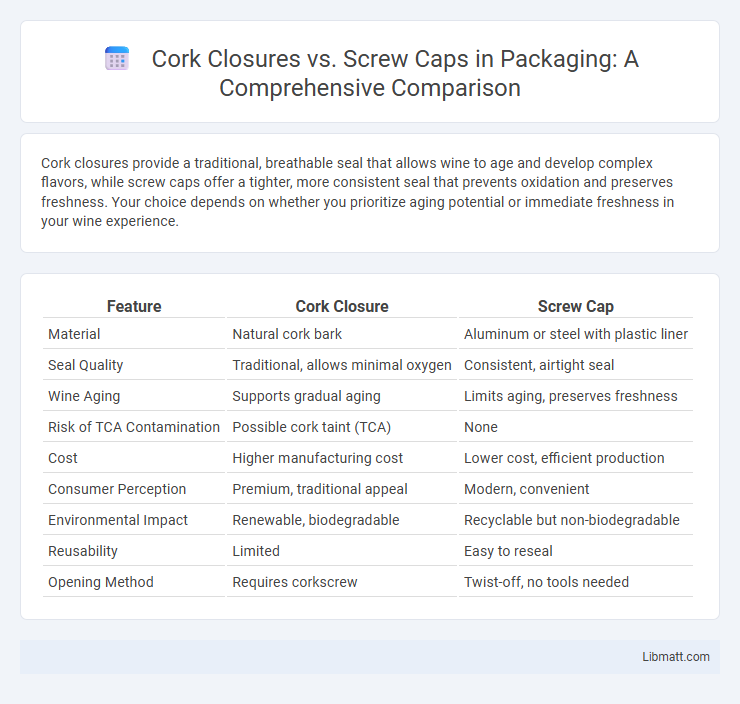Cork closures provide a traditional, breathable seal that allows wine to age and develop complex flavors, while screw caps offer a tighter, more consistent seal that prevents oxidation and preserves freshness. Your choice depends on whether you prioritize aging potential or immediate freshness in your wine experience.
Table of Comparison
| Feature | Cork Closure | Screw Cap |
|---|---|---|
| Material | Natural cork bark | Aluminum or steel with plastic liner |
| Seal Quality | Traditional, allows minimal oxygen | Consistent, airtight seal |
| Wine Aging | Supports gradual aging | Limits aging, preserves freshness |
| Risk of TCA Contamination | Possible cork taint (TCA) | None |
| Cost | Higher manufacturing cost | Lower cost, efficient production |
| Consumer Perception | Premium, traditional appeal | Modern, convenient |
| Environmental Impact | Renewable, biodegradable | Recyclable but non-biodegradable |
| Reusability | Limited | Easy to reseal |
| Opening Method | Requires corkscrew | Twist-off, no tools needed |
Introduction to Wine Bottle Closures
Wine bottle closures primarily include natural cork and screw caps, each offering distinct advantages for preserving wine quality. Cork closures allow limited oxygen exchange, enhancing the aging process, while screw caps provide a tight seal that prevents oxidation and spoilage. Your choice between cork and screw cap influences wine freshness, aging potential, and overall taste profile.
The History of Cork Closures
Cork closures have been used since ancient times, with evidence dating back to the Greeks and Romans who valued cork for its buoyancy and airtight sealing properties. Over centuries, cork became the preferred closure in the wine industry due to its natural elasticity and ability to allow micro-oxygenation, which improves wine aging. Your choice between cork closure and screw cap involves considering this rich historical legacy versus modern convenience and consistency offered by screw caps.
Emergence of Screw Caps in the Wine Industry
The emergence of screw caps in the wine industry revolutionized bottle sealing by offering a reliable alternative to traditional cork closures, reducing the risk of cork taint caused by TCA contamination. Screw caps provide a consistent airtight seal, enhancing wine preservation and aging potential, particularly for white and aromatic wines. This shift gained momentum in regions like Australia and New Zealand, where winemakers prioritized quality control and consumer satisfaction over longstanding cork traditions.
Material Composition: Cork vs. Screw Cap
Cork closures are made from natural bark harvested from cork oak trees, providing elasticity and breathability that influence wine aging. Screw caps typically consist of aluminum and a plastic or synthetic liner, offering an airtight seal that prevents oxidation and minimizes spoilage risks. Your choice between cork and screw cap impacts wine preservation, flavor development, and closure material sustainability.
Impact on Wine Aging and Preservation
Cork closures allow micro-oxygenation, which supports gradual wine aging and enhances flavor complexity over time, making them ideal for premium wines designed for long-term cellaring. Screw caps provide an airtight seal that prevents oxygen ingress, preserving freshness and fruit-forward characteristics, which suits wines intended for early consumption or short-term aging. Your choice between cork and screw cap directly influences the wine's aging potential and preservation, depending on the desired maturation profile.
Environmental Sustainability and Recycling
Cork closures offer superior environmental sustainability due to their renewable and biodegradable nature, harvested from cork oak trees without harming the environment, supporting biodiversity and carbon sequestration. In contrast, screw caps, typically made from aluminum, require more energy-intensive production processes but are highly recyclable within existing metal recycling systems. You can enhance your wine's eco-friendliness by choosing cork closures, which not only reduce waste but also promote sustainable forestry practices.
Cost Comparison: Production and Consumer Impact
Cork closures generally involve higher production costs due to natural material sourcing and labor-intensive manufacturing, leading to a premium price for consumers. Screw caps offer a more cost-effective alternative with lower production expenses and consistent quality control, resulting in reduced retail prices. Your choice between cork and screw cap affects both the overall cost and the wine's aging potential, influencing long-term value.
Consumer Perceptions and Preferences
Consumers often perceive cork closures as a symbol of tradition and quality, associating them with premium wines and a tactile opening experience. Screw caps are increasingly favored for their practicality, consistency in preserving wine freshness, and ease of use, appealing to modern consumers seeking convenience. Your choice between cork and screw cap should consider consumer preferences related to wine type, occasion, and desired bottle experience.
Common Myths and Misconceptions
Cork closures are often incorrectly believed to enhance wine aging more than screw caps, but studies show screw caps provide superior airtight seals, preserving freshness and preventing oxidation. Many people assume corks guarantee quality and tradition, yet cork taint (TCA contamination) affects 3-7% of bottled wines, a problem virtually eliminated by screw caps. Your choice between cork and screw cap should consider wine style and storage conditions rather than outdated myths about flavor or prestige.
Choosing the Right Closure for Your Wine
Selecting the right closure for your wine involves understanding the benefits of cork closures versus screw caps. Cork closures provide traditional aging potential and allow micro-oxygenation, enhancing complex flavors in premium wines. Screw caps ensure a reliable, airtight seal, preventing oxidation and preserving freshness, especially suitable for young and aromatic wines.
Cork closure vs screw cap Infographic

 libmatt.com
libmatt.com